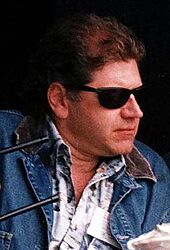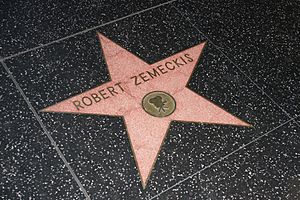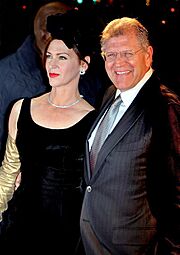Robert Zemeckis facts for kids
Quick facts for kids
Robert Zemeckis
|
|
|---|---|
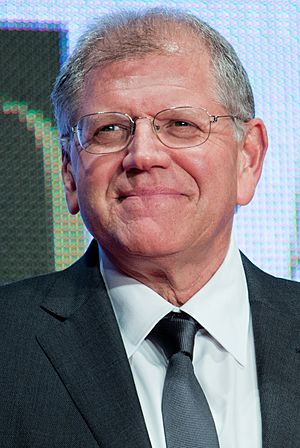
Zemeckis in 2015
|
|
| Born |
Robert Lee Zemeckis
May 14, 1952 |
| Other names | Bob Zemeckis |
| Alma mater | Northern Illinois University University of Southern California (BFA) |
| Occupation |
|
| Years active | 1972–present |
| Political party | Democratic |
| Spouse(s) |
|
| Children | 4 |
| Awards | Accolades |
Robert Lee Zemeckis (born May 14, 1952) is an American filmmaker. He is famous for directing and producing many successful movies. His films often use amazing visual effects combined with great stories. He has won an Academy Award and a Golden Globe Award. He was also nominated for five British Academy Film Awards.
Zemeckis started his career directing comedies like I Wanna Hold Your Hand (1978) and Romancing the Stone (1984). He became very well-known for directing the Back to the Future movies (1985–1990). He also directed Who Framed Roger Rabbit (1988) and Forrest Gump (1994). Forrest Gump won Academy Awards for Best Picture and Best Director.
He has directed other popular films such as Death Becomes Her (1992), Contact (1997), and Cast Away (2000). Zemeckis has also explored motion capture technology in animated films. These include The Polar Express (2004) and A Christmas Carol (2009). He often works with film composer Alan Silvestri and has directed Tom Hanks in five movies.
Contents
Robert Zemeckis: Early Life and Education
Robert Lee Zemeckis was born on May 14, 1952, in Chicago. His parents were Rosa and Alphonse Zemeckis. His father's family came from Lithuania, and his mother's family was from Italy.
Zemeckis grew up in a working class neighborhood in Chicago. He went to a Catholic grade school and then to Fenger Academy High School. He has said that his family didn't have much art or books. He found his inspiration in television.
As a child, he loved TV and was fascinated by his parents' home movie camera. He started by filming family events. Soon, he began making his own short films with friends. These films even included stop-motion and other visual effects. He learned about film schools from watching The Tonight Show Starring Johnny Carson.
After seeing the movie Bonnie and Clyde, Zemeckis decided he wanted to go to film school. His parents were worried because it seemed like an impossible dream for someone from their background.
Zemeckis first attended Northern Illinois University. During a summer break, he worked as a film cutter for NBC News in Chicago. He also edited commercials. He then applied to transfer to the University of Southern California's USC School of Cinematic Arts in Los Angeles. He got in after an "impassioned plea" and showing a music video he made.
At USC, Zemeckis met another student, writer Bob Gale. They both wanted to make Hollywood movies, not artsy films. Zemeckis graduated from USC in 1973.
Zemeckis's Film Career: From Comedies to Blockbusters
How Robert Zemeckis Started in Film
Zemeckis won a Student Academy Award for his film A Field of Honor. This caught the attention of Steven Spielberg. Spielberg became Zemeckis's mentor. He helped produce Zemeckis's first two films. These films were I Wanna Hold Your Hand (1978) and Used Cars (1980). Both were liked by critics but didn't make much money.
After these films, Zemeckis had trouble finding work. But he and Bob Gale kept writing scripts. One of their ideas, Back to the Future, was turned down by many studios. Then, in 1984, Michael Douglas hired Zemeckis to direct Romancing the Stone. This romantic adventure film was a surprise hit. While making it, Zemeckis met composer Alan Silvestri. Silvestri has scored all of Zemeckis's movies since then.
Breakthrough Success with Back to the Future
After Romancing the Stone became a hit, Zemeckis finally got to direct Back to the Future. This 1985 film starred Michael J. Fox and Christopher Lloyd. It was a huge success and led to two sequels: Back to the Future Part II (1989) and Back to the Future Part III (1990).
Before the sequels, Zemeckis directed Who Framed Roger Rabbit (1988). This unique film mixed live-action actors with traditional animation. It was very expensive to make but was a big success. It also won three Academy Awards.
In 1992, Zemeckis directed Death Becomes Her, a dark comedy. His next film, Forrest Gump (1994), was his biggest success. It starred Tom Hanks as a man who accidentally takes part in major historical events. The film made $677 million worldwide. It won six Academy Awards, including Best Picture and Best Director for Zemeckis. From this point on, Tom Hanks and Zemeckis worked together often.
In 1997, Zemeckis directed Contact. This film was based on Carl Sagan's novel about a woman who believes she has contacted aliens. Around this time, Zemeckis also started his own company, ImageMovers.
Robert Zemeckis's Work in the 2000s and Beyond
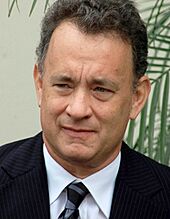
In the late 1990s, Zemeckis worked on a film called The Castaway with Tom Hanks. The story was about a man stranded on a tropical island. Because Hanks's character needed to lose a lot of weight for the film, Zemeckis decided to shoot another movie in between. This other film was What Lies Beneath, a thriller starring Harrison Ford and Michelle Pfeiffer. What Lies Beneath was released in July 2000 and did well. Cast Away, starring Hanks, was released in December 2000. Hanks was nominated for an Academy Award for his role.
In 2004, Zemeckis and Hanks worked together again on The Polar Express. This film was based on a children's book. It was one of the first movies to use motion capture technology. This technique records actors' movements and uses them to create animated characters. The New York Times called it a turning point in filmmaking.
Zemeckis continued to use motion capture in films like Beowulf (2007) and A Christmas Carol (2009). In A Christmas Carol, Jim Carrey played many roles, including Ebenezer Scrooge. Zemeckis was a big supporter of 3-D digital cinema.
After a period of focusing on motion capture, Zemeckis returned to live-action films. He directed Flight, a drama starring Denzel Washington. In 2014, it was announced that a stage musical based on his first Back to the Future film was being made. Zemeckis helped write the musical.
In 2015, he directed The Walk. This film was about Philippe Petit's amazing tightrope walk between the World Trade Center towers. In 2016, he directed Allied, a romantic thriller set during World War II. He then directed Welcome to Marwen (2018) and The Witches (2020).
In 2022, Zemeckis directed a live-action adaptation of Pinocchio for Disney+. Tom Hanks played Geppetto in this film. This was their fourth movie together. In 2024, Zemeckis directed Here, which also stars Tom Hanks.
Zemeckis's Unique Style and Achievements
Robert Zemeckis is known for being a pioneer in visual effects. He was one of the first directors to use computer graphics in live-action films. You can see this in Back to the Future Part II and Forrest Gump. He also famously combined hand-drawn animation with live-action in Who Framed Roger Rabbit. His use of motion capture in films like The Polar Express also set new standards.
He often works with composer Alan Silvestri. Film critic David Thomson has said that Zemeckis uses visual effects in a very dramatic way to tell his stories.
Robert Zemeckis: Personal Life
Zemeckis has mentioned that he focused so much on his career that he sometimes put his personal life second. He was married to actress Mary Ellen Trainor and they had a son, Alexander Francis. They later divorced. On December 4, 2001, he married Leslie Harter, an actress. They have three children together.
Zemeckis is also a private pilot. He enjoys flying his own plane. He owns a villa in the Tuscany region of Italy, which is part of a 10th-century castle. He uses it for summer vacations.
Filmography Highlights
Feature Films Directed by Robert Zemeckis
| Year | Title | Director | Writer | Producer |
|---|---|---|---|---|
| 1978 | I Wanna Hold Your Hand | Yes | Yes | No |
| 1980 | Used Cars | Yes | Yes | No |
| 1984 | Romancing the Stone | Yes | No | No |
| 1985 | Back to the Future | Yes | Yes | No |
| 1988 | Who Framed Roger Rabbit | Yes | No | No |
| 1989 | Back to the Future Part II | Yes | Story | No |
| 1990 | Back to the Future Part III | Yes | Story | No |
| 1992 | Death Becomes Her | Yes | No | Yes |
| 1994 | Forrest Gump | Yes | No | No |
| 1997 | Contact | Yes | No | Yes |
| 2000 | What Lies Beneath | Yes | No | Yes |
| Cast Away | Yes | No | Yes | |
| 2004 | The Polar Express | Yes | Yes | Yes |
| 2007 | Beowulf | Yes | No | Yes |
| 2009 | A Christmas Carol | Yes | Yes | Yes |
| 2012 | Flight | Yes | No | Yes |
| 2015 | The Walk | Yes | Yes | Yes |
| 2016 | Allied | Yes | No | Yes |
| 2018 | Welcome to Marwen | Yes | Yes | Yes |
| 2020 | The Witches | Yes | Yes | Yes |
| 2022 | Pinocchio | Yes | Yes | Yes |
| 2024 | Here | Yes | Yes | Yes |
Television Work
| Year | Title | Director | Executive producer |
Creator | Notes |
|---|---|---|---|---|---|
| 1986 | Amazing Stories | Yes | No | No | Episode: "Go to the Head of the Class" |
| 1989–1996 | Tales from the Crypt | Yes | Yes | No | Executive producer: all episodes Director: "And All Through the House", "Yellow", and "You, Murderer" |
| 1991–1992 | Back to the Future | No | No | Yes | |
| 2018–2023 | Manifest | No | Yes | No | |
| 2019–2020 | Project Blue Book | No | Yes | No |
Awards and Recognition
Robert Zemeckis has received many awards for his work.
- In 1994, he won the Academy Award for Best Director for Forrest Gump.
- He also won the Golden Globe Award for Best Director for Forrest Gump in 1994.
- In 1996, he received the Golden Plate Award from the Academy of Achievement.
- In 2004, Zemeckis received a star on the Hollywood Walk of Fame. This is a special honor for his work in motion pictures.
See also
 In Spanish: Robert Zemeckis para niños
In Spanish: Robert Zemeckis para niños


